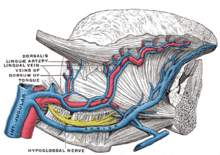Lingual artery
The lingual artery (" tongue artery") is the artery that supplies the tongue in humans and mammals . It arises as the second main trunk from the external carotid artery ( Arteria carotis externa ), in horses and cattle as Truncus linguofacialis ("tongue-face-trunk") together with the arteria facialis . At the front edge of the hyoglossus muscle , it gives off the sublingual artery , which supplies the floor of the oral cavity. In animals, shortly after its origin it releases the ascending palatal artery ( arteria palatina ascendens ) to supply thePalate .
The lingual artery runs between two muscles of the sub- tongue muscles ( musculus hyoglossus and musculus genioglossus ) up to the tip of the tongue. It is strongly curled to compensate for tongue movements.
literature
- Theodor H. Schiebler (Ed.): Anatomie. Histology, history of development, macroscopic and microscopic anatomy, topography. Taking into account the item catalog. 9th, completely revised edition. Springer, Heidelberg 2005, ISBN 3-540-21966-8 .
- Uwe Gille: Cardiovascular and immune system, Angiologia. In: Franz-Viktor Salomon, Hans Geyer, Uwe Gille (Ed.): Anatomy for veterinary medicine. 2nd, revised and expanded edition. Enke, Stuttgart 2008, ISBN 978-3-8304-1075-1 , pp. 404-463.
